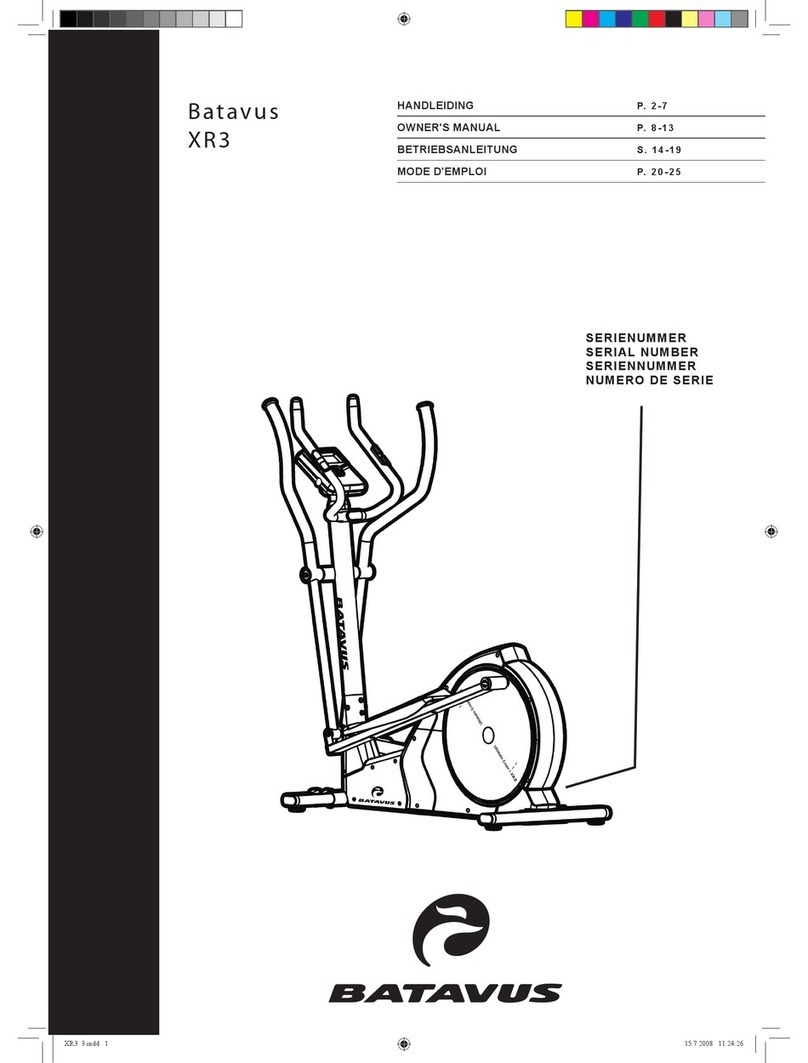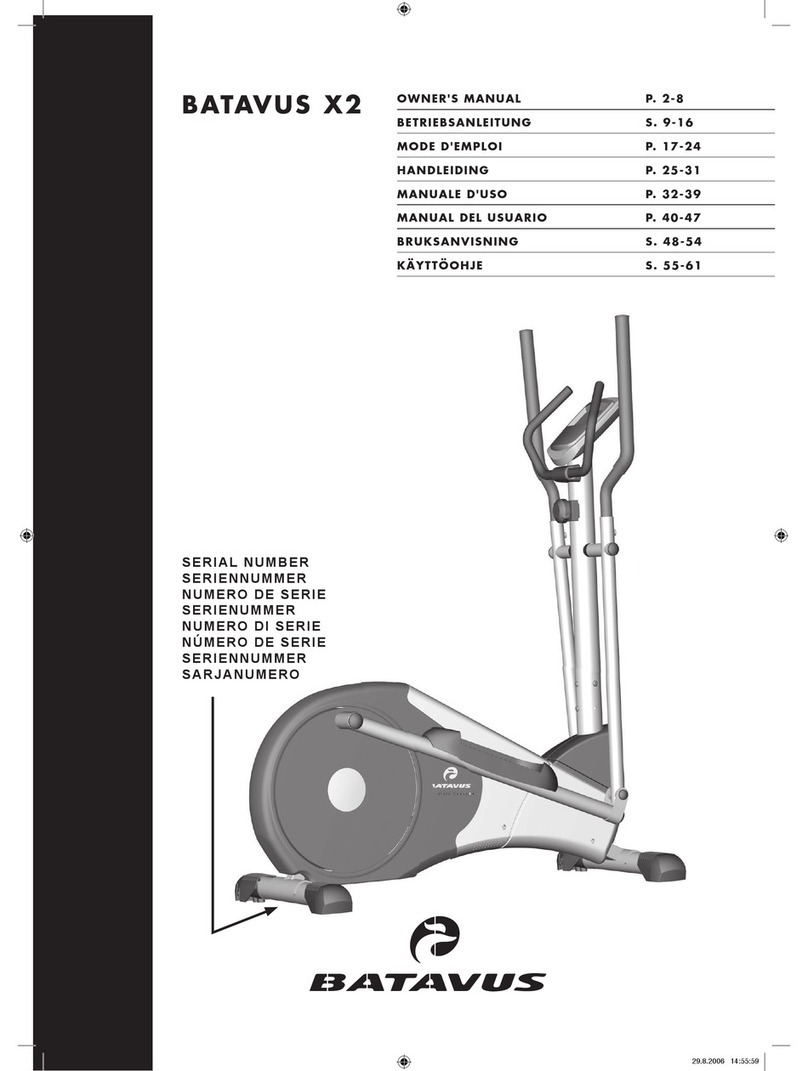
6
OWNER'S MANUAL •BATAVUS
If you feel sideway play in the pedal cranks, tighten
the front end shaft nuts until the play disappears.
Mount the device by grasping the fixed handle
support of the device. Place your foot on the foot
plate which is in the lower position and stable.
Dismount the device when the pedal arms have
stopped moving completely. Dismount by grasping
the fixed handle support of the device.
EXERCISE LEVEL
Working out using a crosstrainer is excellent
aerobic exercise, the principle being that the
exercise should be suitably light, but of long
duration. Aerobic exercise is based on improving
the body’s maximum oxygen uptake, which in turn
improves endurance and fitness. The ability of the
body to burn fat as a fuel is directly dependent on
its oxygen uptake capacity. Aerobic exercise should
above all be pleasant. You should perspire, but you
should not get out of breath during the workout.
You must, for example, be able to speak and not
just pant while exercising. You should exercise at
least three times a week, 30 minutes at a time, to
reach a basic fitness level. Maintaining this level
requires a few exercise sessions each week. Once
the basic condition has been reached, it is easily
improved, simply by increasing the number of
exercise sessions. Exercise is always rewarding for
weight loss, because it is the only way of increasing
the energy spent by the body. This is why it is
always worthwhile to combine regular exercise
with a healthy diet. A dieter should exercise daily
- at first 30 minutes or less at a time, gradually
increasing the daily workout time to one hour.
Start your workout with slow tempo and low
resistance. Gradually increase tempo and resistance
according to your own condition. Keep your head
up and neck long in order to avoid stress on your
neck, shoulders and back. Keep also your back
straight. Make sure that your feet are centered on
the foot pedals and that your hips, knees, ankles
and toes are facing forward. Keep your body
weight centered over your lower body regardless of
whether you lean forward or stand upright. Stop
your workout by gradually decreasing tempo and
resistance.
If you wish to strengthen your upper body muscles,
lean slightly forward and focus on working with
your arms. Grab the handles somewhat higher than
normally to enhance the movement, but avoid
getting your shoulders sore. For dual training,
set the resistance sufficiently high and focus on
actively using upper and lower body muscles
simultaneously. You should feel the effects of
training in whole body.
To develop upper body muscles, lean forward
slightly and focus on pulling and pushing the
handle supports with your hands. Grasping the
supports somewhat higher will intensify the
movement, but be careful not to get your shoulders
sore. To develop upper and lower body muscles
simultaneously, increase the resistance slightly and
focus on using the upper and lower extremities
simultaneously so that you feel resistance as they
are both actively working.
HEART RATE
No matter what your goal, you’ll get the best
results by training at the right level of effort, and
the best measure is your own heart rate.
First find your maximum heart rate i.e. where the
rate doesn’t increase with added effort. BATAVUS’s
meter calculates your approximate maximum pulse
level using the following formula:
220 – AGE
The maximum varies from person to person. The
maximum heart-rate diminishes on average by one
point per year. If you belong to a risk group, ask
a doctor to measure your maximum heart rate for
you.
We have defined three different heart-rate zones to
help you with targeted training.
BEGINNER •50-60 % of maximum heart-rate.
Also suitable for weight-watchers, convalescents
and those who haven’t exercised for a long time.
Three sessions a week of at least a half-hour each
is recommended. Regular exercise considerably
improves beginners’ respiratory and circulatory
performance and you will quickly feel your
improvement.
TRAINER •60-70 % of maximum heart-rate.
Perfect for improving and maintaining fitness.
Even reasonable effort develops the heart and lungs
effectively, training for a minimum of 30 minutes
at least three times a week. To improve your
condition still further, increase either frequency or
effort, but not both at the same time!
ACTIVE TRAINER •70-80 % of maximum heart-
rate.
Exercise at this level suits only the fittest and
presupposes long-endurance workouts.
•The heart rate is measured in three ways:
A) Using the handgrip heart rate sensors
B) Using an ear clip with cable (available as an
optional extra)
C) Using a chest strap (wireless, telemetric),
optional
batavusX4.indd 6batavusX4.indd 6 12.10.2005 12:49:3912.10.2005 12:49:39






























